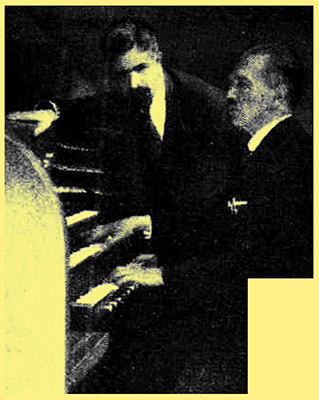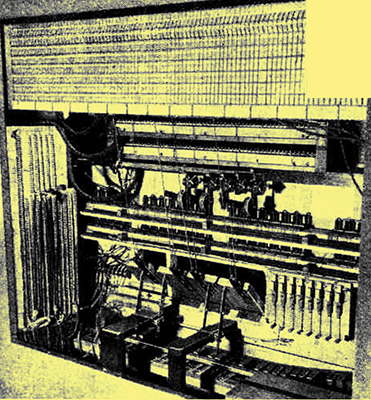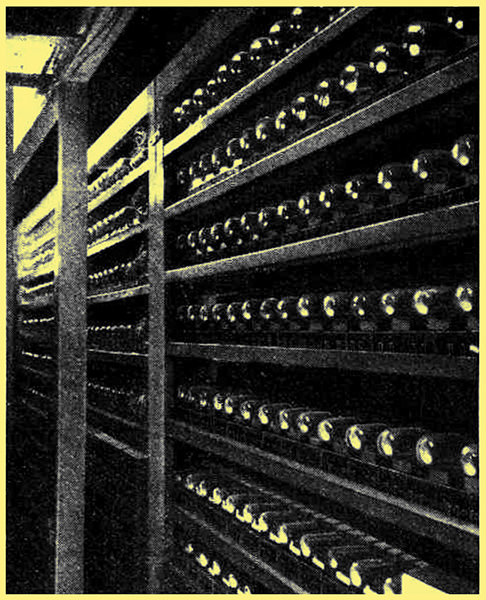|
Triode oscillations and filtered harmonics

M Couplex, constructor of the organ, at the keyboard. With him is M Givelet, the inventor and designer.
Many readers of The Wireless World who have heard recitals on the peculiar organ at 'Poste Parisien' must have wondered how the very remarkable tonal effects are obtained. The organ has three manuals, each of four and a half octaves. together with two and a half octaves of pedals, making a total of two hundred notes. For each of these notes a triode is provided, with its associated oscillatory circuit, this comprising a fixed capacitor and an iron-cored inductance. Tuning is effected within narrow limits by a screw adjustment of the iron core. This method would appear to be much simpler than tuning an ordinary organ, but it would be interesting to know to what extent variations in supply voltage, valve ageing, and the like affect the tuning.
Another 200 triodes are fitted in the amplifiers, which feed thirteen loud speakers. There are seventy-six registers, of which sixty-six are electronic and the other ten (mostly 'effects') pneumatic. Altogether, including couplers, there are ninety five stops, and it has been said that there is a close similarity between the resources of this organ and the very large and famous instrument at Notre Dame, although the latter, presumably, does not include drums, rattles, triangles, castanets, an auto-horn or a steam whistle!
Tone quality, it is officially explained, is produced by reason of the fact that the wave forms of the oscillatory circuits are very rich in harmonics, and that the 'stops' actuate groups of filters which remove various harmonics to introduce changes in tone-colour. The question of 'attack' seems to have received no attention, the depression of a note of the keyboard merely starting the valve oscillating, so that, whatever register is in use, the sound commences in exactly the same manner. This appears to be a serious disadvantage, for it is well known that a considerable part of the tone-colour effect depends on the attack or beginning of the note; if, for example, a trumpet register has the same smooth attack as that of a flute stop, no amount of filtration will restore the full difference of tone-colour.

The interior of the playing console. Note the pedal operated rheostat for obtaining a 'swell' effect.
Points in favour of the new instrument include the 'swell' action, with a pedal operated rheostat, applied to the whole of the organ, and not only to one or, more rarely, two manuals, as in the case of the normal organ. This is a really important improvement, provided that it does not tend to sentimental playing of the cinema-organ type. Again, the response of the oscillatory circuit to the depression of the key being practically instantaneous, a note can be repeated rapidly in a manner not possible with pipes, especially in the lower registers. Consequently, more music should become available for the organ without transcription, and composers can write passages of a nature that up till now would have been unplayable. Whether this is any great advantage, leading as it does chiefly towards an increase of floridity, may perhaps be questioned.
A point of special interest in the case of the Poste Parisicn organ is that transmission by wireless comes direct, it being obviously unnecessary to convert electrical into acoustical energy by means of the loud speakers when performing on the air.
A very attractive advantage is the ease with which auxiliary 'organs' can be fitted. If the normal organ is at the west end of a church and a similar organ is needed for accompanying the choir, or. if echo effects are desired. all that would be necessary in the case of an electronic instrument would be the installation of an extra group of loud speakers suitably situated.
Probably, however, the outstanding advantage of the new instrument is its extreme compactness. The console is of normal size, the loud speakers can be installed quite unobtrusively, while the 400 valves with all their associated coils, capacitors, etc., take up a total space of only about 6 × 8 × 1 ft - about an eighth of the space occupied by the new organ at Broadcasting House!

The bank of 400 valves, 200 of which are amplifiers. Variation in tone-colour is obtained by means of harmonic filters
|